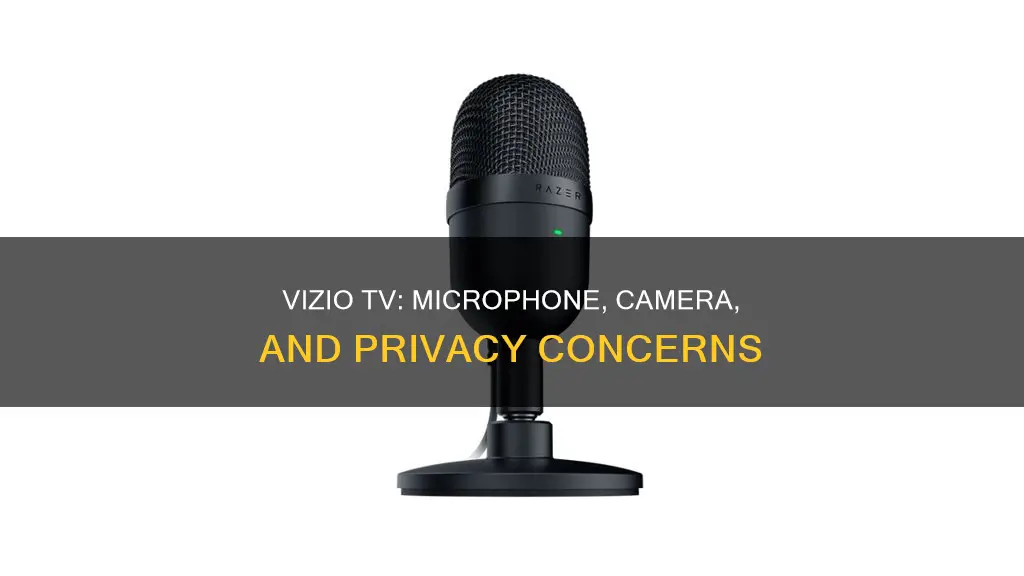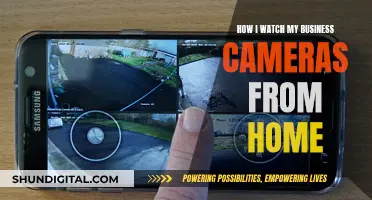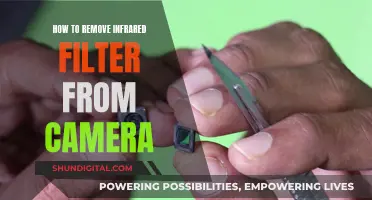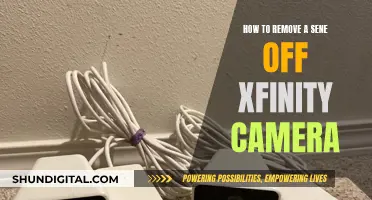
Vizio is a popular TV maker that was fined $2.2 million by the FTC for tracking and selling user data without consent. The company tracked users' viewing habits and personal information, such as sex, age, income, and marital status, through a process called automated content recognition (ACR). While Vizio claims that the data collection is necessary to keep prices low, it is important for users to be aware of the privacy implications of owning a smart TV. Vizio TVs do have the capability to support external webcams and microphones, but users can disable data collection and tracking features through the TV's settings.
| Characteristics | Values |
|---|---|
| Has a microphone and camera | Vizio TVs do not have a built-in microphone and camera. However, Vizio Internet App televisions sold in retail stores as of August 2013 and some older models can support an external webcam, called the Vizio TV Video Camera, which includes a built-in microphone. |
| Tracking capabilities | Vizio TVs have been found to track user data without consent. The company was fined $2.2 million for this. |
| How to disable tracking | To disable tracking on Vizio TVs, go to Menu > Settings > Smart Interactivity, or any option with Automated Content Recognition, and turn it off. |
What You'll Learn

Vizio fined $2.2 million for tracking and selling user data without consent
Vizio, one of the world's largest manufacturers and sellers of internet-connected "smart" televisions, was fined $2.2 million by the Federal Trade Commission (FTC) and the state of New Jersey for tracking and selling user data without consent. The company was found to have secretly collected and sold information about viewers' watching habits, including capturing second-by-second information about the video displayed on the smart TVs. This included details about the channels, streaming services, DVDs, and Blu-ray discs being watched.
Vizio used a process called automated content recognition (ACR) or pixel analysis to collect this data. They also collected IP addresses and other personal information such as sex, age, income, marital status, household size, education level, home ownership, and household value. This data was then sold to advertisers and marketers, who used it for targeted advertising.
The FTC and the New Jersey Attorney General charged Vizio with failing to properly disclose its data collection practices and obtain consent from consumers. The company agreed to settle the charges and pay the $2.2 million fine, which included $1.5 million to the FTC and $1 million to the New Jersey Division of Consumer Affairs, with $300,000 of that amount suspended. As part of the settlement, Vizio was required to delete all the data collected before March 1, 2016, and to implement a new privacy program to obtain specific consent from users for its data collection practices. The settlement also required Vizio to prominently disclose its data collection and sharing practices and prohibited the company from making misrepresentations about the privacy and security of consumer information.
The fine against Vizio highlights the growing concerns around consumer privacy and data transparency in the age of connected devices. While smart TVs from other manufacturers also collect similar data, Vizio's lack of transparency and failure to obtain consent from users led to the FTC's intervention. This case serves as a reminder for companies to be transparent about their data collection practices and obtain proper consent from consumers.
Watching Cameras: A Tough Job?
You may want to see also

Vizio's response to the fine
In February 2017, Vizio was fined $2.2 million for tracking and selling user data without consent. The company was found to have collected data about viewers' personal habits from 11 million smart TV sets and sold this data to advertisers and marketers without informing consumers or obtaining their consent.
In response to the fine, Vizio's General Counsel, Jerry Huang, stated:
> Going forward, this resolution sets a new standard for best industry privacy practices for the collection and analysis of data collected from today’s internet-connected televisions and other home devices. The ACR program never paired viewing data with personally identifiable information such as name or contact information, and the Commission did not allege or contend otherwise.
Despite this statement, Vizio faced backlash from customers who felt that the company was indifferent to their concerns and that the updates ruined their TV experience. Many customers threatened to stop purchasing Vizio products and some even took to advising others against buying Vizio TVs.
Following the fine, Vizio was ordered by the court to prominently disclose and obtain affirmative express consent for its data collection and sharing practices. The company was also required to delete all collected data by June 6 of that year.
Employee Surveillance: UK Legalities of Watching Staff on Camera
You may want to see also

How to disable tracking on Vizio TVs
Vizio TVs have been found to track and sell user data without consent. The company has been fined $2.2 million for collecting data about viewers' personal habits and selling the data to advertisers and marketers without consent. The data collected includes information about the "sex, age, income, marital status, household size, education level, home ownership, and household value".
If you own a Vizio TV, you can disable tracking by following these steps:
For older Vizio TV sets that use Vizio Internet Apps (VIA), which were sold before 2011:
- Press the Menu button on your remote control.
- Open Settings.
- Highlight Smart Interactivity.
- Switch it to Off.
For newer Vizio TV sets with the VIA Plus interface, sold between 2011 and 2016:
- Press the Menu button on your remote control.
- Open Settings.
- Select System.
- Select Reset and Admin.
- Highlight Smart Interactivity.
- Press the right arrow to turn it off.
For Vizio smart TVs that use the newer SmartCast system:
- Go to System.
- Select Reset & Admin.
- Select Viewing Data.
- Toggle it to Off.
By disabling Smart Interactivity, you can stop Vizio from tracking your viewing habits and selling your data to third parties. It is important to note that disabling tracking may not affect data that has already been collected, and third parties who purchased the data may not be forced to delete it.
Insignia Roku TV: Does It Have a Camera?
You may want to see also

How to use an external webcam with a Vizio TV
Vizio TVs that feature Vizio Internet Apps (VIA) provide a range of apps, including Skype, which can be used for virtual meetings. All VIA TVs sold in retail stores as of August 2013, and some older models, can support an external webcam, which Vizio calls a TV Video Camera. The webcam you need to make Skype calls on a Vizio TV is the Vizio Internet Apps TV Video Camera, which is sold directly by Vizio. No other webcam can be used with Vizio televisions because the software on the device isn't compatible with the software on the TV. The Vizio TV Video Camera includes four built-in microphones and should be mounted on top of the television for the best picture and audio quality. To help the camera pick up your voice, sit directly in front of the microphone and three to 12 feet from the camera.
To set up an external webcam with a Vizio TV, follow these steps:
- Open the box and unfold the base of the webcam. Position the webcam on top of the TV. If you prefer, you can use the included tape to position the webcam instead of the base.
- Plug the USB cable of the webcam into any empty USB port on the TV.
- When you turn on the TV, the webcam will be automatically detected.
- Sign in to your Skype account. Calls from Skype to Skype are free on Vizio, but a high-speed internet connection is required.
- To use Skype, ensure you have a working internet connection. Launch Skype and log in to your account.
- In Skype, click on "Options" or "Tools," then select "Video Device Settings."
- Choose the Vizio TV Video Camera from the drop-down list of webcam options.
- Adjust and test your webcam to ensure it is working correctly.
Note: The only app on a Vizio TV that uses a webcam is Skype.
Paranoia or Reality: FBI Surveillance via My Camera?
You may want to see also

How to disable tracking on other smart TVs
Vizio TVs have been in the news for tracking and selling user data without consent. The company was fined $2.2 million for this data breach. The data was collected through a process called automated content recognition (ACR) which takes partial screenshots to figure out which channel viewers were tuned to and to tell which DVDs, Blu-ray discs or streaming services they were watching. ACR is not the only way data is collected. Data is also collected through tracking what shows you watch, which apps you open, and matching your viewing data with web browsing from other devices.
Opt out of ads and tracking
The easiest option is to opt out of the ads and tracking where possible. Due to laws like Europe's General Data Protection Regulation and the 2020 California Consumer Privacy Act, TVs sold in the United States have to offer users a way to opt out of most tracking and data collection.
Turn off ACR
Turning off ACR will stop most data collection with a single setting change. However, it is not a one-size-fits-all solution as data collection methods vary widely between brands. The process is also made more difficult by the fact that the options are buried deep in the settings and tracking features are given benign-sounding names.
Block unwanted traffic on your network
If you want to keep the ability to stream while filtering out the ads and tracking you don't want, you can try to actively block just the unwanted traffic on your network. This can be done with a device called a Pi-hole, a Raspberry Pi-based device that applies ad-blocking scripts to every device on your network and lets you monitor outgoing traffic.
Disconnect your TV from the internet
Another simple method for cutting off any data practices that you find unwelcome is to stop it at the source, the internet connection. When setting up your TV, don't connect it to Wi-Fi or plug in an Ethernet line. With no internet connectivity, your smart TV remains pretty dumb. If you already have a smart TV set up, you can still lobotomize it by performing a factory reset, which will wipe all of your apps and settings, but also lets you set up the TV like new, complete with the opportunity to skip the Wi-Fi sign-in.
Buy a dumb TV
The easiest way to keep your TV private, without all the extra stuff, is to never invite it into your home. You can buy a dumb TV, one made just for flipping through channels and pulling in local stations. You can always add a measure of smart functionality by picking up one of the best streaming devices, but be aware that every streaming device will have some combination of data gathering and advertising.
School Bus Camera Footage: Who's Watching?
You may want to see also
Frequently asked questions
Vizio TVs do not have a built-in microphone or camera. However, Vizio Internet App televisions sold in retail stores as of August 2013, and some older models, can support an external webcam, which Vizio calls a TV Video Camera.
The Vizio TV camera connects to your compatible Vizio television with a USB cable. Open the box, unfold the base, and position the webcam on top of the TV. Then, plug in the USB cable on the webcam to any empty USB port on the TV. When you turn on the television, the webcam will be automatically detected.
The only app on a Vizio television that uses a webcam is Skype. To use it, sign in to your account after connecting the webcam. Calls from Skype to Skype are free on Vizio, but you need a high-speed internet connection.
To disable tracking on Vizio TVs sold between 2011 and 2016, press the Menu button on your remote, open Settings, select System, followed by Reset and Admin. Then, scroll down to Smart Interactivity and switch it off.







